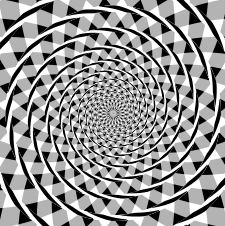Fraser spiral illusion
The Fraser spiral illusion is an optical illusion that was first described by the British psychologist James Fraser in 1908. The illusion is also known as the false spiral, or by its original name, the twisted cord illusion. In this illusion, overlapping black arc segments appear to form a spiral; in reality, the arcs are a series of concentric circles. Although the Fraser spiral illusion and other similar illusions have not been completely explained, they has stimulated much valuable research into human perceptual processes. They have also been utilized by artists to bring about entertaining and impressive effects in their works.
Discovery
The Fraser spiral illusion is named for British psychologist James Fraser. Fraser published his findings in a 1908 edition of the British Journal of Psychology, in an article entitled "A New Visual Illusion of Direction." Fraser noted in reporting this new illusion that
In all the hitherto published visual illusions of direction, with the exception of the Chequerboard or Münsterberg illusion, the illusory lines or bands are definitely continuous, uninterrupted in character of black or white, on a contrasting background. In the illusion of direction here described each illusory band consists of a series of visibly discrete similar parts, all inclined at the same small angle to the line of direction of the series to which they belong. Such visibly discrete similar parts may be conveniently termed 'units of direction'.[1]
Description
When looking at a Fraser spiral, one sees what appears to be a spiral of twisted rope against a checkerboard pattern. In reality, the arcs that make up the "spiral" are actually a series of concentric circles.
Explanation
The visual distortion is produced by combining a regular line pattern (the circles) with misaligned parts (the differently colored strands or "twists"), an effect that is augmented by the spiral components of the background. The Zollner illusion and the cafe wall illusion, like many other visual effects, are based on a similar principle in which a sequence of tilted elements causes the eye to perceive an image incorrectly. The Fraser spiral illusion, along with other similar phenomena, is created by the way the retina and brain process the images.
Applications
The Fraser spiral, like other perceptual illusions, is useful in the study of perception and vision. The way optical illusions are perceived in the brain gives researchers information regarding how images are processed and interpreted. Such effects are also utilized by artists to intriguing images that fascinate and entertain the public.
Notes
- ↑ Fraser, James. 1908. "A New Visual Illusion of Direction" British Journal of Psychology. Retrieved October 30, 2007.
ReferencesISBN links support NWE through referral fees
- Bruce, Vicki. Unsolved Mysteries Of The Mind: Tutorial Essays In Cognition. Psychology Press, 1996. ISBN 0863773938
- Fraser, J. "A New Visual Illusion of Direction." Brit J Psych, 2 (1908):307–320.
- Morgan, M.J. and B. Moulden. "The Münsterberg figure and twisted cords." Vision Research, 26 (1986):1793–1800.
- Ninio, Jacques. The Science of Illusions, Cornell University Press, 2001. ISBN 0801437709
External links
All links retrieved May 9, 2017.
- Fraser's Spiral from MathWorld
- An interactive Fraser Spiral
- Fraser Spiral
- Excerpts from Fraser's "A new visual illusion of direction," published in 1908
Credits
New World Encyclopedia writers and editors rewrote and completed the Wikipedia article in accordance with New World Encyclopedia standards. This article abides by terms of the Creative Commons CC-by-sa 3.0 License (CC-by-sa), which may be used and disseminated with proper attribution. Credit is due under the terms of this license that can reference both the New World Encyclopedia contributors and the selfless volunteer contributors of the Wikimedia Foundation. To cite this article click here for a list of acceptable citing formats.The history of earlier contributions by wikipedians is accessible to researchers here:
The history of this article since it was imported to New World Encyclopedia:
Note: Some restrictions may apply to use of individual images which are separately licensed.
